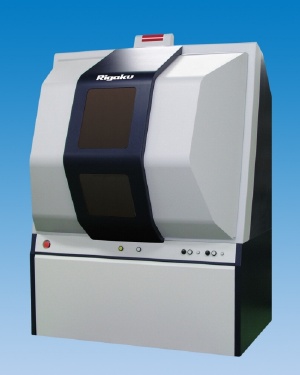Rigaku SmartLab 9KW X-Ray Diffractometer

The Rigaku SmartLab x-ray diffraction system (XRD) is a fully automated, modular system for advanced x-ray diffraction measurements on a wide range of materials including thin films and powders. The system uses a high power, 9 kW rotating anode x-ray generator which allows faster collection times with less background noise and is optimized for advanced thin film measurements. This state of the art XRD can be used to determine the crystal structure and identify the phases of thin films and bulk materials. The SmartLab is easy to use and is fully equipped with modules for performing a variety of advanced x-ray diffraction measurements such as x-ray reflectivity, grazing incidence diffraction, reciprocal space maps, rocking curves, and small angle x-ray scattering (SAXS). The SmartLab Guidance software guides the user through alignments and experimental setups, making the system very easy to use.
Specifications/Capabilities:
► 9 kW rotating anode (Cu target) x-ray generator .
► X-ray generator ranges: 20 kV to 45 kV; 10 mA to 200 mA.
► Scintillation point detector and a high-speed position sensitive detector system.
► Five axis high resolution goniometer with X-Y-Z and Rx–Ry sample stages.
► Parallel beam optics with a multi-layer x-ray mirror.
► Bragg Brentano focusing optics.
► Computer controlled variable divergence slit and receiving slit (~30µm).
► 3 channel cut monochromators: germanium (220) 2-bounce and 4-bounce, germanium (400) 2-bounce, and a germanium (220) 2-bounce analyzer.
►Micro-focus Optics Unit CBO-f: Small area measurement 100µm2.
Supported Sample Sizes:
► Maximum wafer diameter: 150 mm (6 in).
► Small pieces supported: Yes.
► Support for powders: Yes.
Typical Applications:
► Bragg Brentano powder diffraction: Determine the composition of powders and polycrystalline thin films.
► High resolution XRD (HRXRD): Determine the structure of epitaxial thin films including film composition, thickness, orientation, and superlattice period. Characterize the defects in epitaxial thin films such as mismatch, lattice strain relaxation, misorientation, dislocation density, surface damage, and curvature.
► X-ray reflectivity (XRR): Determine the properties of the top most layer such as thin film layer thickness, surface and interface roughness, density or composition.
► Rocking curves: Determine the composition and defects in epitaxial or nearly epitaxial films.
► Grazing incidence XRD (GIXRD): Determine the lattice strain in highly textured polycrystalline films and the composition, defects, and crystallite size of polycrystalline thin films.
► In plane grazing incidence XRD: Determine the composition, defects, orientation and residual stress in textured polycrystalline thin films.
► Small Angle x-ray Scattering (SAXS): Determine the size and size distribution of nanomaterials. Reflection and transmission mode using a high-resolution 2D camera. Structure parameter size of 1nm-200 nm.
